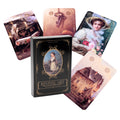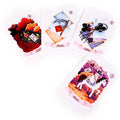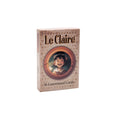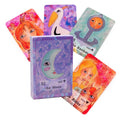1799 Original UR-Lenormand Guidebook
(auch als Personenkarte)
- 5. Baum: Gesundheit, Leben, Wurzeln und
Krone; Zeit: es dauert noch lange
- 6. Wolken: Unklarheiten, ungeklarte (men- tale) Probleme. Aber auch: Vogelperspektive, „auf Wolke 7"
- 7. Schlange: Platte Instinkte, Verfuhrung oder
Hoherentwicklung, Weisheit, Heilkraft ■<
- 8. Sarg: Ende, Krankheit, Abschied, Loslassen, (aktive) Beendigung, „ein Problem begraben"
- 9. BlumenstrauB: Geschenk, Einladung, Zu-
friedenheit, Kreativitat und Vielfalt I
- 1 Sense: Gefahr, unerwartete Entwicklung,
Schreck, aber auch Ernte, Nachhaltigkeit I
- 1 Rute: Streit, Kommunikation, Diskussion, | Bereinigung
- 1 Vogel: Liebe und Erotik, Freiheit, Leichtig- keit, Uberblick, Abgehobenheit, „einen Vogel haben"
- 1 Kind: Kind, Neuanfang, Neugier, Un-
schuld, unbelastet; klein, bald, rasch # <
- 1 Fuchs: Betrug, auch Selbstbetrug, Lugen <
usw., aber auch List, Klugheit I
- 1 Bar: Personenkarte, Chef oder Chefin, alte- i
Introduction
THE GAME OF HOPE - a title fit for a great novel! The game was conceived by Johann Kaspar Hechtel and published in Nuremberg in 1799. It was a parlour game, a game with everyday situations with all their significance and twists. This is where we meet all the characters seen later in the Lenormand cards: the rider, the snake, the ship, the house, the bears, the ring, the coffin, the cross, etc.
THE game of hope was designed at a time when the conception of being responsible for and having mastery over one's own life became popular; one's personal journey through life was also seen as a series of events driven by fate. There's luck and bad luck and the hand of
f 8 Jfe
43 {ft*
fate but people also have the ability and the duty to take their life into their own hands.
Thus arose a parlour game that reflected this perception of life. The aim of the game is to get through it successfully, collecting capital (tokens) along the way. The winner is the first player to reach card 35 (the anchor), the symbol of hope. If the dice lead you to the next hand, the cross, then you're stuck there for a while.
Hope reigns in real life too, as the line between success and failure is a slim one. When you land where in the game depends not on the cards, as these are always dealt out in ascending order; rather it is the dice that decide the course of fate. That too corresponds to real life, in which the order of many things is immutable.
The whole structure of this game - the journey through life determined by fate, hope, malaise - suggests the use of an oracle. There is even a brief reference to this in the instructions. It
wasn't until fifty years later, however, when the old dice game had been forgotten that the cards were revived - this time as fortune-telling cards, allegedly found in the possession of the deceased French fortune-teller Madame Lenormand. Through her name, the cards have been steadily growing in popularity since the middle of the 19th century.
However, it was not until recently, since the year 2000, that these cards experienced a boom in popularity in many part of the (western) world that had not been seen before. Millions of people today now use Lenormand cards!
It is this cultural development that makes Lenormand cards impressive. It shows why the basis of the oracle is attentiveness; how one deals with the 'hand of fate', a coincidental meeting, a sign or even a card that is dealt, how you allow yourself to be inspired by these 'coincidences' or 'signs' comes down to your innermost reception, your attitude to life. This is the key to the interpretative power of these
and other cards. They won't predict a lottery win or a car accident but they can inspire you to actively deal with the many possibilities that our perception and our daily lives offer us.
The Game of Hope
In 1799, the Gustav Philipp Jakob Bieling publishing house in the city of Nuremberg, well- known for its games, released 'The Game of Hope, a pleasant parlour game with 36 illuminated (!) figure cards, included' at a price of 30 kreutzers.
The author of the game was Johann Kaspar Hechtel, who had already created several other works for the same publishing house; a silly question and answer game, a collection of verse for family albums and a selection of new card games, forfeits and other games.
It can be seen from the focus of the publishing house that they were interested in good-quality entertainment for people, not in esoteric or occult matters, and so this latest publication was also a parlour game. It was sold and
played as such, in accordance with the following, carefully phrased instructions:
THE
GAME OF HOPE
Willi a new figures’ card in illuminated
36 sheets
2nd improved edition.
This game may be played with as many people as want to take part, and every player puts 6 to 8 marks into a pot. The 36 illuminated cards are laid out in a square, that is, in 6 rows of 6 sheets each according to the numbers on top of the cards, that is 1, 2, 3 and so on, up to 36.
After every player has taken up a mark or sign, each in turn casts two ordinary dice. Each player moves their mark the number of pips cast starting at the first card. For example, a player who has cast 4 and 1 moves to the fifth card. When it is the turn of this person for the second time, he moves the number of the pips starting from the 5th card and so on until the
47 tfe
end of the game. The order of I he game can be determined by the dice, for example it may be agreed that the player with the highest number of pips will begin the game and the one with the lowest number will start last. If two people cast the same number of pips, they arc equal and they have to throw again.
On each of the 36 sheets, when a player puts his mark down, he meets with a figure there, which is favourable or unfavourable or indifferent to him. I call those sheets indifferent which have no influence on the progress or regress of the game, but where the mark remains standing quietly until the next round.
The following sheets are favourable or unfavourable:
No. 3: The one who throws 3 pips and thus gets to the Ship will be happily taken by this ship to the Canary Islands, where the well-known beautiful birds are at home, no. 12.
No. 4: On entry in this House, two marks have to be given up to the doorkeeper.
Mo. 6: The Thundercloud drives back to no. 2.
No. 7: To stay safe from the bite of this dangerous Snake, 3 marks have to be paid.
No. 8: The one who gets to this Coffin is deemed to be dead until another player comes to this sheet or until he casts a double, for when it is his turn to roll the dice he is not excluded.
No. 11: So as not to be castigated by this Rod, one pays two marks. For this one can move forward two more sheets - to the Lad on no. 13.
No. 14: The cunning Fox leads the player astray and he has to find refuge in the Wood at no. 5.
No. 16: Arriving at the Star of good prospects, the player receives 6 marks.
No. 19: To enjoy the pleasant vista from the Tower, one pays 2 marks.
No. 21: On these steep Alps, the player has to remain until another arrives to release him or he has to cast a double.
No. 22: Unnoticed, this path leads around the
49
mountains right back to the Garden at no. 20.
No. 24: hoever wins this Heart will immediately offer it to the Young Gentleman al no. 28 or to the Young Lady al no. 29. That is to say, if the player arriving at the card 24 is a woman, she will move up to 28, if it is a man to 29.
No. 25: hoever finds this Ring gets 3 marks.
No. 26: W hoever reads in this Grimoire will by a hex therein be forcefully returned to the Garden in no. 20.
No. 27: Whoever receives this Letter has to pay a fee of 2 marks for the bearer.
No. 28: This Young Gentleman leads on to the brilliant Sun of hope in no. 31. However for those who got here by way of the Heart, no. 24, this does not happen. They wait here for the next turn.
No. 29: The Young Lady leads on to no. 32, unless one has come here through the Heart.
No. 33: On reaching this Key, one receives 2 marks.
No. 34: Reaching the Fish, one has to pay
2 marks.
No. 35: This is the most important sheet of the whole game, insofar as the one, who comes to stay on this picture of Hope has won the game and draws the whole cash-box or deposit.
No. 36: So near to the luckiest field, the player is cheated as against his w ill he has to advance one step too far to the figure of the Cross, where he has to remain until another player takes this burden off him or he throws a double.
If a player casts a number, w hich leads over the 36 cards, he has to count back as many numbers as he would move beyond the 36. For example, he stands on 32 and casts 8, therefore he has to go back 4 numbers, because these are in excess of 36 and comes to stay at 28. Also, it is not possible to take the cash box by counting back an excess to 36 but only in the advance movement. For example, if someone stands at 29 and casts a 6, he arrives in orderly fashion at the Anchor of Flope and has won the whole game.
If phncrs want to add more a arid} Io the entertainment of the game. say. In working in riddles, forfeits de.. this is easily done and any part} »ill be able to find sheets to which these can be added as rewards or penalties. For example. sheets nos. 2. 5. 9, 13, 15, 18, 23, 30, 32, 36 ma\ be declared as forfeits, whenever they are reached in the order!} way, on 10, 12, 17, 20. 29. 35 it is required to sing songs of friendship and health-wishing, for which you can find any number of proposals in the book Selection of t he Most Excellent Songs of Friendship published by the same publisher.
In order to play any conceivable card game ith ordinary German and French playing cards with these 36 figure cards for further entertainment, the German and French card pictures have been included al the top of the cards. It is only sometimes necessary to leave the Sixes and the Sevens out of the game. Also, this makes it very easy Lo learn to compare the German and French cards.
W ith these same cards it is also possible to play an entertaining game of oracles by shuffling
the 36 cards and then letting the person, for whom the oracle is meant, cut the cards, then laying out the cards in 5 rows with 4 rows at 8 cards each and the fifth row with the remaining 4 cards. If the person querying is a woman, one starts from sheet 29, spinning a jocular tale from the cards nearby around the figures on display. If it is for a man, the tale is started from sheet 28 and again makes use of the cards surrounding this one. This will bring much entertainment to any merry company.
The fact that even Hechtel was able to fall back on a precursor is the subject of further investigations, the results of which we do not wish to anticipate.
Publication of Lenormand cards in 1846
It was not until fifty years later that the figures from the game of hope re-appeared, this time in the publishing house of J. F. August Reiff in Koblenz. Decades had since passed and the creator of the GAME OF HOPE was
£^53 {Fa
long dead. In 1794, Koblenz was occupied by French troops and between 1801 and 1815, it belonged to France. Many people in Koblenz had a French father and the cultural influence of the neighbouring country could still be felt even once the area belonged to Prussia. News came from France in 1843 that the famous fortune teller Madame Lenormand had died. People knew that she had used cards but hardly anyone knew which cards.
That soon changed; Reiff published a reprint of the game of hope. It came out with the famous fortune teller's name on it to catch people's eyes and was sold as the game that people close to her claimed had been found on her when she died.
In the list of new books issued by the Hinrichs book store in Leipzig, the game first appeared in the first half of 1846. Adverts for it had already appeared in newspapers in February of that year. The game was so successful that soon other publishers brought out similar games.
The meaning of I he cards
If you wish to use the game of hope for card-reading then it is important that you learn about the meaning of the cards' symbols. The history of this game being used for fortune telling has shown clearly that there are several different approaches for this type of interpretation and some of them can be exceptionally inspiring.
The cards give us food for thought and invite us to think about people close to us, our career prospects and more.
Past events can be recognised as firmly in the past and new doors opened. This psychological interpretation can bring clarity to even complicated situations and shine a light on our future. Here is a brief note on some of the current interpretations of the cards:
- 1. Rider: (Good) news, movement.
- 2. Clover: Luck, good outcome, vegetative; time: short, not rushing, 'let the grass grow over it'
n-TRwWJ
- 3. Ship: Travel, distance, change; also: commit to steering a course
- 4. House: Stability, home, family, identity (also as a character card)
- 5. Tree: Health, life, roots and crown; time: it will take a while
- 6. Clouds: lack of clarity, unresolved (mental) problems, but also: bird's eye view, 'on cloud nine'
- 7. Snake: Natural instincts, seduction or upward development, wisdom, healing
- 8. Coffin: End, illness, saying goodbye, letting go (active) ending, 'putting a problem to bed'
- 9. Flowers: Present, invitation, satisfaction, creativity and diversity
- 1 Scythe: Danger, unexpected development, fear, but also harvest, sustainability
- 1 Birchrod: Conflict, communication, discussion, cleansing
- 1 Birds: Love and eroticism, freedom, lightness, overview, remoteness, 'to be crazy'
- 1 Child: Child, new beginning, curiosity, innocence, untainted; small, soon, quick
- 1 Fox: Deceit, also self-deceit, lies, etc, but
also cunning, cleverness
- 1 Bear: Character card, boss, older person or official, strength, power, possession
- 1 Stars: Clarity, inspiration, spirituality, one's '■ own place in the cosmos, searching and finding
- 1 Stork: Changes, going on a journey, moving house, flexibility; desire to have children
- 1 Dog: Loyalty, friendship, bond, hold on; time: lasting
- 1 Tower: Ivory tower or watchtower, something prominent, person in position of leadership; loneliness or attentiveness
- 2 Park: Openness, meeting, something will become clear. Nature, leisure time, community
- 2 Mountain: Blockade, obstacle, 'hurdle', diversion; incentive, task, achieving something significant
- 2 Paths: Decision, choice, several possibilities, one's own path
- 2 Mice: Something is 'nagging', loss, failure; but also kind, resilient
- 2 Heart: Love, partnership; good and not so good passions
eHj 57 Jfe
- 2 Ring: Friendship, marriage, also contracts, agreements; round objects, something going in a circle; jewellery, (self-) worth
- 2 Book: Secret, reserve, unknown, entertainment, education, knowledge, skill
- 2 Letter: Message, phone etc, notice, sympathy, need
- 2 Gentleman: Enquirer or man of one's dreams
- 2 Lady: Enquirer or woman of one's dreams
- 3 Lilies: Harmony, sexuality, intimacy, true beauty
- 3 Sun: Warmth, energy, creativity, life force, dazzling light
- 3 Moon: Mirror of the soul, feelings, intuition, psyche, also fame and glory, social recognition, but also dreams, life at night
- 3 Key: Access and barriers, solution, fulfilment
- 3 Fish: Finances, richness, unknown, 'as happy as a lark'
- 3 Anchor: Work, calling, standing firm, (self-) awareness
- 3 Cross: Fate, karma, crossroads; burden, purpose, mission in life
How one links together pictograms such as the key, letter, tree, snake or house depends on the cultural factors of the time as well as one's own experiences. What could a dream about a child, a ring or a rider mean? How did painters or writers view these motifs? What personal desires or fears could be linked to these symbols?
When it comes to these questions, we can use the cards not only for a funny 'fortune telling game', as suggested by the first instructions, but can also consult them, either in the traditional or modern manner, as an oracle and 'talking mirror' (Johannes Fiebig).











































